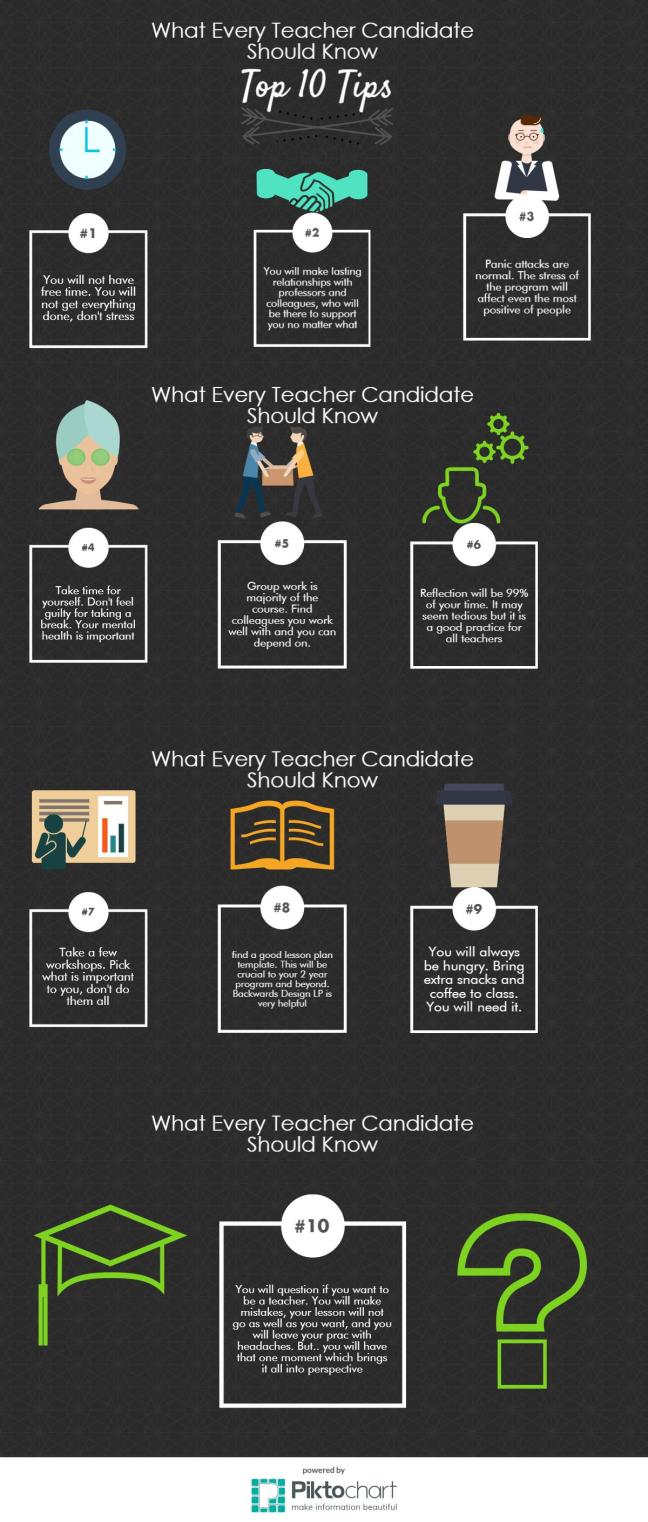
Google Keep: Pros, Cons, and Uses In A Classroom

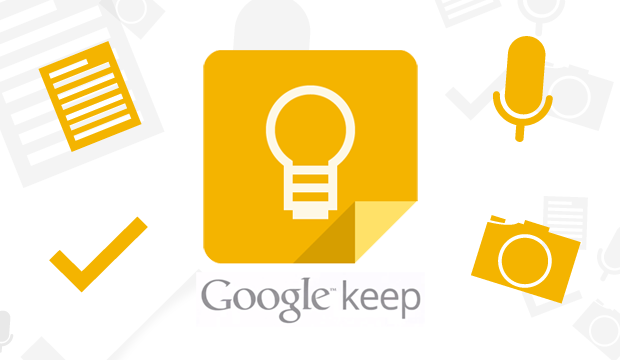
Google keep is a google app that makes it easy to take quick notes, create to-do lists, or save important information. It is known as digital post it notes.
To access Google Keep you can go to keep.google.com. You can also log into your google account and go to apps. Google Keep does not show up on the first drop down menu so you need to go to more to access it.
In Google Keep you can make notes, change the colours of notes, add labels, and add images. You can then search through all your notes based on colours, or labels. You can also draw notes, import notes to google docs and grab image text. To see how to do this refer to the video below.
The app is free but you need a computer and a google account to access the app.
Note: Within my classroom I would have a BYOD policy
How students could use google keep in the classroom:
- Organize their thoughts, ideas, to-do lists for a research topic or essay.
When writing a research paper or essay sometimes it is hard to put everything in order. You may find information that is important but are not sure where to put it. With google keep you can import your notes separately by opening a new google doc ( also found in your apps on the first page, make sure you are using the same google account), clicking tools → keep notepad and drag your notes into the order you want. It is similar to a puzzle of your own thoughts where you can rearrange the order without having to type, retype, and erase because the original order makes no sense.
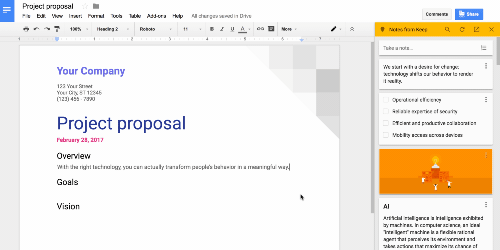
- Grab and save whiteboard notes.
When the teacher is writing on the whiteboard a student can take a picture, and save it to Google Keep. From there the student could colour code the note based on subjects, or label the note. For instance the date the whiteboard notes were written, or perhaps based on topic, example math- algebra.
- Connects other people with to-do lists.
Students can share their notes with others by entering names or e-mail addresses. This way students can collaborate together on projects within and outside of class, there is not repetition of information, and if a partner is sick the notes are still available. Notes can also be shared with the teacher to look at the progression of a project and perhaps give feedback and next steps.
- Save resources to a note with one click.
If students are doing a project and they find something that really related but they do not have time to read everything they can quickly in the Google Chrome web browser ( if the Google Chrome Keep Chrome extension has been added) by clicking the lightbulb button in the top right corner of the browser. Right from here students can type text and a label and check the note out later.
- Transcribe printed notes or words into text.
For example, a student took a photo of a body of text, they can choose the option to grab image text, allowing students to manipulate what was written. This may be very beneficial if they want to directly quote something, or if they have a handout of a template and they don’t want to retype it. Then they can expand on it. Perhaps you want to take sections out of a picture book and ask students to highlight important information in the text. As a teacher I see a benefit of not breaking copyright law by photocopying books, and save on paper!
- Search your ideas.
Students are working on a particular project and only want to see posts related to that, simply type in a keyword. Students could also type in a colour, or label if they organized information that way. This feature even works for images that have text in them. Compared to a traditional note book this is very beneficial to students because will not spend time flipping through pages trying to find that nugget of important information they wanted to add to your project.
- Offline Note Taking
When google keep is being used during class time, during a lecture all devices can be switched to airplane mode. When google keep is being used for note taking, then the internet should not be needed. Pictures and drawings can still be added offline. The app
also has an autosave feature in case a device becomes unresponsive or the user
forgets to save.
- Integration with Other Google Apps.
As mentioned above in number 1 notes from google keep can be transferred to google docs. Another app that google keeps interacts with is the google calendar. By setting a reminder within your note students can set a reminder of a test, or a project that needs to be handed in. Any note can be set as a reminder.
Downfalls of Google Keep in The Classroom
- You cannot add videos
- Will eventually become outdated
- Need access to a computer
- Cannot create numbered lists
- Cannot bold, italicize, and underline text
- Cannot attach a file
- No location based tagging
- Inability to undo changes or go back to a previous version of a note
- A search command within a note
Materials I used:
http://blog.appsevents.com/2014/08/using-google-keep-in-classroom.html
http://ditchthattextbook.com/2017/03/10/meet-google-keep-and-6-ways-it-can-help-schools/
Tower Garden: Linking Education To Real World Experiences
At the beginning of the year at Connaught Public School, my grade 4/5 class began on a very interesting project called Food and Finance: Growing Futures. The program began in the fall and was created by Karen Secord, the director of the Parkdale Food Centre. She was one of a group of Canadians handpicked to take part in a recent program put on by the Banff Centre aimed at finding new solutions to economic inequality.
Tower gardens were purchased for several schools in Ottawa including Devinshire, and Fisher Public School.
At the beginning of the school year the tower garden was displayed for the students to look at with a sign on it that said what is this?
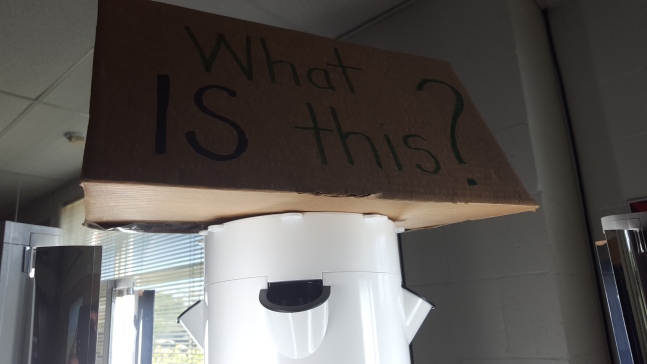
Students wrote down their ideas and we placed them in a container. Some guesses included bird nest, watering tower, and a humidifier. Just this simple sign inspired inquiry and exploration of this new foreign object in their classroom.
Eventually we told the class that it was a tower garden. A tower garden in case you don’t know is a tower that pumps water up throughout the tower to pods that hold plants. The plants grow with water and light, but no soil. Nutrients are added from plastic bottles and only plants that are not root vegetables can be planted in the garden.
Michelle Richardson and I documented the impact the tower garden was having on the classroom though google forms. It was anonymous and students gave their opinion on several questions.
After some time Wentsi Yeung-the owner of Culture Kumbucha-came to our classroom. She had heard about the tower garden and proposed a business model to the grade 4/5 class to be in partnership with them. The proposal was that the class would grow basil, thyme, and mint for Wentsi, and she would then buy the herbs from them at market price. The students listened to her proposal, discussed the pros and cons, and ultimately agreed to be her business partner. Students wrote letters of acceptance to Wentsi and their business began.
Up until the last time I was there the students had made $ 39.76 from their sale of not only the herbs to Wentsi, but also lettuce they sold to the Parkdale Food Centre, for families in need of fresh food at relatively low cost.
Our classroom was featured in the Ottawa Citizen , you can click the link to learn more about the project and watch the video
Youtube: Measurement Conversion Song

I taught measurement for a grade 4 and 5 class. Previous to this lesson, we talked about measurement in base ten units and worked from mm–>cm–>dm–>m. To consolidate student understanding we had a day where students worked in partners and cut and measured pieces of paper, writing the measurement on the back. The measurement was to be in 3 different types of measurement. Each partner was to hold a strip of paper up to their partner and then ask the partner how many mm long is this paper, for example( they chose to quiz their partner with either mm,cm,or dm). The partner would try to guess as best as possible the correct answer, and if the partner was within a good range they would keep that piece of paper in a pile. Once all strips had been collected, the partner with the most pieces of paper won. Before the activity I played a YouTube video which is a song about measurement. The YouTube video was meant to engage students in the material before demonstrating understanding through the game. I used the Grade 5 Nelson Math Book to find the strips game I used later with the students pictured here .
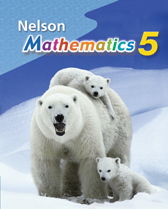
Using a video from YouTube augmented student learning because it showed students visual examples of measurements and the different conversions between them. Seen in the last image, different units of measurement are also compared using different colours, to point out mili- and centi-, another form of patterning seen in measurement.
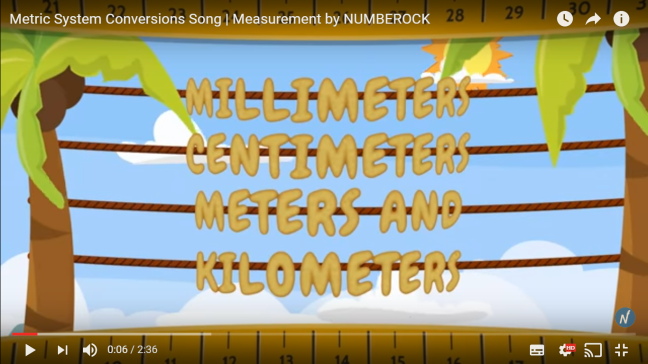
There is also a person in the video who looks like a “cool dude”, so instill the idea that math can be fun. Examples used in the video consist of everyday objects, and show measurement in terms of thickness, distance, and height.
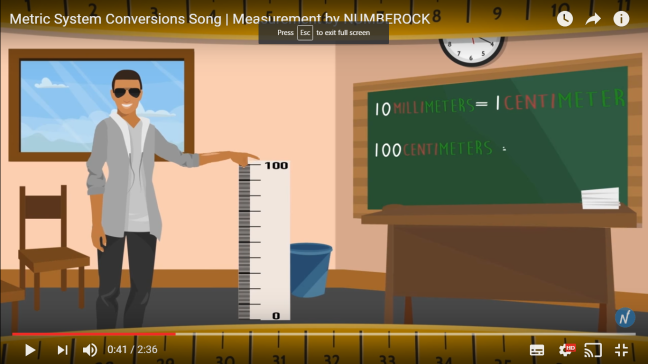
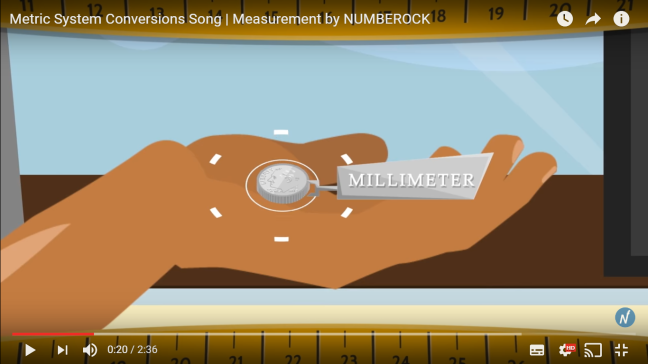
The video was created to showcase a catchy song that they could follow to remember their conversions. I made sure to show this video after the theoretical explanation of conversions, instead of just giving them rules. It also augments learning because YouTube is a public tool that anyone can access and students can give real comments to the videos they watch.
The images may be distracting to some students, or be too overwhelming for some students, such as students who have epilepsy or ADHD because there are some quick changes in colour, and many moving pieces. You need to know your students before showing them videos because you may have students with exceptionalities that may feel left out because they cannot follow along with the video. The main character in this video is also a male, only what is assumed to be a females hand (because of the painted nails) is seen very quickly.
As a class, students could create their own measurement song that could then be put into YouTube and shared with the public. I would also try
![]()
Edpuzzle, which is a tool that allows you to add questions, comments, and audio tracks to pre-existing videos. BY adding questions within the video, I can make sure students understand the material in the video, rather than having them just feed me the same information back. Or, I could have students make their own Edpuzzle to show their understanding. Students could comment on the video and compare and contrast other measurement videos to determine what videos worked better than others and why.
YouTube is free and you do not need an account to access it. However, you need to make sure ahead of time that the content is appropriate for your viewers, and you cannot make comments on videos if you do not have an account.
Links that I used:
https://socialstudiesexplorer.files.wordpress.com/2015/06/edpuzzle-icons1.jpg
http://www.math5.nelson.com/images/mathematics_5.jpg
edpuzzle.com
http://www.shahid-project.com/wp-content/uploads/2016/11/why_is_it_smart_to_buy_youtube_views.png
Link to the video: www.youtube.com/watch?v=djTNUp4XIR
Inclusion: Only In Spec-Ed?
“Inclusion is not primarily a special education, or even an education, issue. It is a fundamental way of seeing and responding to the human difference for the benefit of everyone involved” (p.4) (page 11).
Inclusion is being pushed so much in school but to me inclusion is a part of my life. I was brought up to make others feel welcome, to help others in need and it never crossed my mind when I was younger that this wasn’t the case. As I have grown older I have noticed that the world is not as inclusive as it seemed when I was just a child. In my first year of teacher’s college I learned about residential schools and how indigenous people were treated. It was shocking and rather unsettling to know that in a Country that is so built on inclusion of all peoples that residential schools ever happened. I felt like I had been lied to, I felt ashamed of my heritage for the first time. Then, recently when I went to Philadelphia in October I noticed again the feeling of being excluded and judged. My boyfriend at the time (now fiancée) and I were with other friends at a thanksgiving festival. I noticed people staring at my boyfriend and I making sneering looks and looking disgusted. I told my fiancée that people were looking at us and he just replied calmly, “ I know”. I asked him why to which he replied, “ its because we are an interracial couple”. I thought to myself what does that have to do with anything?… Just because he is black and I am white people judge us. I didn’t notice it so much when I was in Canada but to think that just walking around in public can make someone feel excluded..was odd. I felt terrible for my fiancée, and angry. In order for inclusion to truly be seen in school, it first needs to be seen in our community, in our province, in our country, and in our world. Sadly, there are many people who discriminate against others for things that they cant even help. People do not choose to be black, or handicapped, or have learning disabilities, or be female. It’s how they are born, or situations that happen. Inclusion is not primarily a special education, it is a way of living.
Hutchinson, N., & Martin, A. (2012). Inclusive Classrooms in Ontario Schools. Toronto, ON: Pearson Canada. 1-22.
Pear Deck: No It’s Not A Fruit

During my two years at Ottawa University in the Bed program I often heard people talking about Pear Deck. I was very confused at first, cards..pears.. that doesn’t make sense. So I googled it. It has been discussed a lot in my courses and I would like to create my own Pear Deck. I had intended to in my practicum but it proved difficult to get access to the computers.
Pear Deck is an tool used for presenting information that is meant to be interactive and engages your audience in their own learning. As a user, you can use a google account to create presentations.
It is a free tool but you can get a premium account which gives you access to draggable slides, drawing slides, google classroom integration, session dashboard and review, student takeaways, unlimited pdf and google slides import, and a priority help desk.
Individuals $99.99/yr
Groups ( 5 Teachers starting at) $449.95/yr
Schools $1499/yr
Pear Deck is used by teachers and students and you must select your role when visiting the website. As a student, you are provided a random code to login to see your teachers Pear Deck. As a teacher you can create or upload a Pear Deck, and one completed you can project the Pear Deck for your students to see. You can have students answer questions, look at images, move their cursors to different statements, and you can lock their interaction with the slideshow. One benefit of Pear Deck is you can see your students answers even after the slideshow is finished.
To learn how to create different Pear Deck slides click here.
To learn how to present your Pear Deck click here.
As well as creating an interactive slide show presentation Pear Deck can also be used as a diagnostic assessment tool before starting a lesson. Ask students if the sun is a star, or which is larger the earth or the sun? This way before you start a lesson you understand where your students misconceptions are. Answers are saved and can be referred back to later, which can help a teacher focus on students who need more support. By answering questions in real time on their devices, students are not centered out in the classroom. They do not need to put their hand up to show their knowledge and understanding. By having students answer questions in real time, it also shows authentic learning. However, for assessment these answers should only be used for assessment for learning, and not evaluated. Finally, teachers can use Pear Deck to consolidate a main idea, or lesson.
Here is an example of a teacher using Pear Deck as a Culminating Science lesson to tie in knowledge students should already have learned.
In this lesson, the teacher shows a demonstration of a reaction, and is asking students whether it is an exothermic or endothermic reaction?
What went well:
- students show their previous knowledge through answering questions
- the teacher places images of what will happen
- the teacher can refer back to students answers
- saves time taking answers from students with hands raised
What can be changed to make it better:
- ask questions that don’t need as lengthy responses
- have less text based answers: visual selections to choose from instead of writing answers
- do not allow students to see each others choices during multiple choice
- lock answers when given, many students change answers to most popular answer
- slow down, have you gotten responses from all students? Pear Deck is meant to involve all students, make sure they are all contributing
Link to featured Image.
Through The Eyes of A Teacher Candidate

Technology, Pros and Cons
Like many teachers before me, I wanted to get involved with technology but did not how to get started. I find sometimes I become very frustrated with tech and I do not know where to go to get help. Thankfully, in my second year of teachers college at Ottawa University, we were given the choice to select an elective. Of the electives offered PED 3119, a course on technology in the classroom was offered.
So far I am enjoying the course and learning new things. It is not without its frustrations though. Already I am having difficulties getting access into the google classroom set up by the professor. I have contacted the tech department several times to resolve the problem. Tomorrow will be a week since the issue started, with very little progress. I hope that by next week I will at least be able to see the google classroom where the rest of my 10 weeks of teachers college will be spent.







